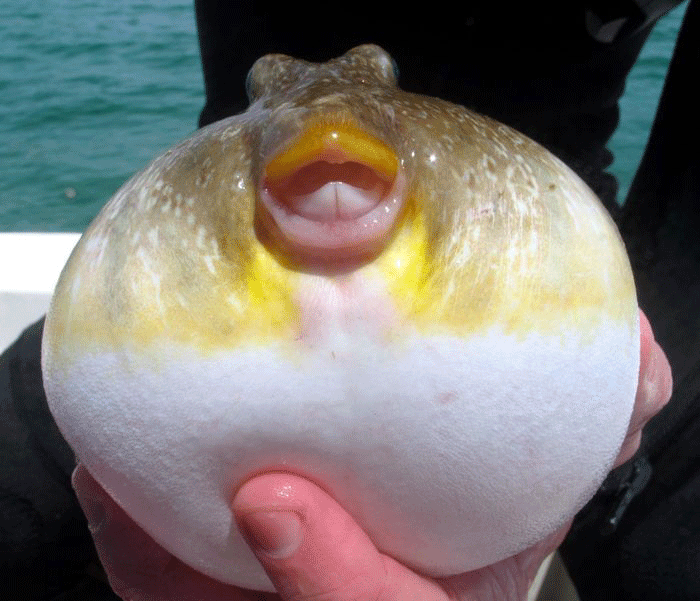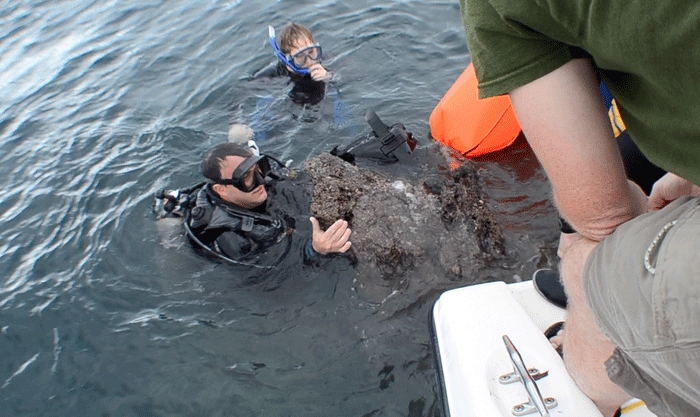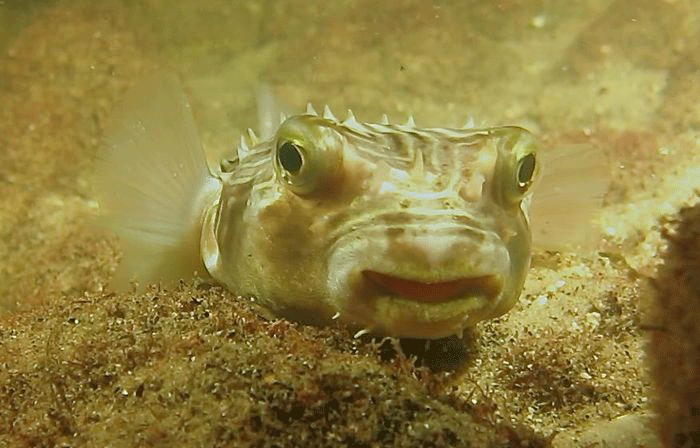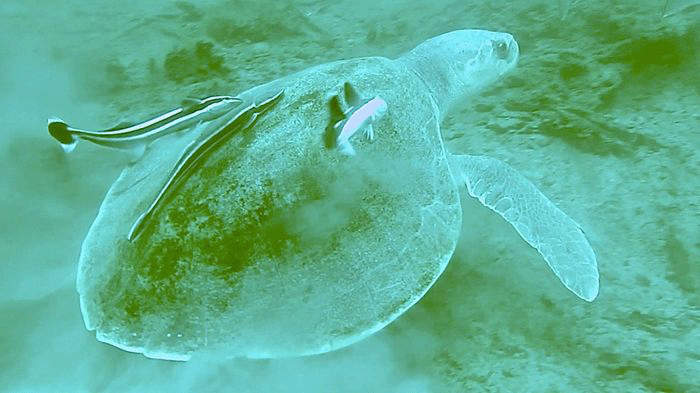Update - Fighting to Protect an Ancient Underwater Forest
Air Date: Week of April 25, 2014

A pufferfish from the site (photo: Ben Raines)
Ten years ago, Hurricane Ivan uncovered an ancient Cypress forest on the bottom of the Gulf of Mexico. Ben Raines of the Weeks Bay Foundation in Alabama tells host Steve Curwood that scientists and conservationists are studying the forest to learn about sea level rise and fighting to protect the wood from salvage companies.
Transcript
CURWOOD: It's Living on Earth, I'm Steve Curwood. When we last spoke with Ben Raines of the Weeks Bay Foundation in Alabama about a year ago, he told us an amazing story about an underwater woodland off the coast of Alabama. A local fisherman had discovered a mysteriously fishy patch of ocean, and when divers checked it out they found a forest of ancient cypress stumps on the ocean floor. Since then, Ben has been collaborating with scientists to study the submerged trees, and working on a documentary about it. He joins us now from Fairhope, Alabama. Welcome back.
RAINES: Hey, thanks for having me back.
CURWOOD: So, Ben, remind us about this forest. What does it look like?
RAINES: Well, there’s an ancient river channel that meanders through the site, and you just see all these logs laying all over the bottom and then stumps projecting up off the bottom. When you get closer and start looking, the logs still have bark. We’re actually finding trees that have lightning scars on them. They’re just incredibly well preserved, and it’s just this magic sort of place that you swim through realizing that you’re traveling back in time 50,000 years.

Divers pull up stumps to be examined (photo: Ben Raines)
CURWOOD: Now, you’ve been working with scientists who’ve been studying this forest over the past year. What have you learned since we last spoke?
RAINES: Well, we’ve learned that some of the individual trees may have been as old as 2,000 years before they died. So these were like redwoods. We’ve got stumps down there that are up to ten feet across, and you don’t see trees like that on the Gulf Coast, and you can’t really imagine them, but before we were here cutting everything down, that’s what was here, just this forest of trees so big, ten people with their arms outstretched couldn’t fit all the way around it holding hands.
CURWOOD: So remind me about what science tells us about the age of this forest again.
RAINES: Well, if you just look at the depth, you would think that it should be about 12,000 to 14,000 years old, but then when we did the actual radio carbon dating, which was done at Lawrence Livermore National Laboratory, they did it three times because they were so puzzled...it came back radio carbon dead which means older than 50,000 years. So what they believe has happened is as Louisiana has gotten heavier over the eons with mud coming down the Mississippi River, weighing down the delta over there, it’s caused the bottom over here to rise up like a bulge, you know, like if you squeeze a balloon it gets bigger in another spot. So the depth here doesn’t appear to be accurate as far as how old the forest is. So now we’re having some uranium dating done of the trees, and that’s going to be done in Taiwan, and it’s a whole new technique, so hopefully we’ll get a very accurate date for when the forest was dry land.

The wood was preserved for thousands of years buried in sediment (photo: Ben Raines)
CURWOOD: But at this point, it’s something more than 50,000 years.
RAINES: Right. And that’s about as precise as we can get right now.
CURWOOD: What’s the latest theory as to how this forest got there? What was the accident in nature that preserved this whole thing?
RAINES: Well, we’re still working on that a little bit, and when we get a more precise date, we may be able to tie it to some sort of event, like a meteor or something like that. The other possibility is a big hurricane. Sea levels were coming up and it may have just shifted sediments enough to bury this stuff, and so once things get covered up, they get protected from oxygen. There’s no decay. So these trees were essentially entombed while they were living, and everything below the oxygen level is still there. That’s why all the trees look like they were cut off at the same height, and when you cut into them with a saw, they still smell fresh like fresh, piney trees and they have sap that oozes out of the cuts.
CURWOOD: So, they’ve been preserved all this time. Why are they exposed now?
RAINES: Well, Hurricane Ivan in 2004 had 90-foot waves, some of the biggest waves ever recorded in the Gulf of Mexico. And we believe one set of these giant waves came through this area and just scoured out about five or six feet of sand and revealed the stumps.
CURWOOD: Now, when we last spoke with you, you were concerned that furniture companies, perhaps guitar companies, would come looking for this forest. What’s happened on that front?
RAINES: Well, you know, the forest kind of went viral last year, and that’s how it came to y’all’s attention, and all these salvage companies started calling and offering to buy the coordinates to the site. Because they wanted to go dig them up, exactly like you said. So we decided to push to have it turned into a national marine sanctuary. We’ve actually made a great deal of headway, and I believe, NOAA, the National Oceanic and Atmospheric Administration, is going to make it a sanctuary where you’ll still be allowed to fish, and you’ll still be allowed to scuba dive, you just won’t be able to steal the stumps off the bottom.

Many different fish species find shelter among the underwater stumps (photo: Ben Raines)
CURWOOD: What other steps are you taking to protect the forest?
RAINES: Well, raising awareness...we started making a documentary, and so we assembled a little film crew and we have a team of scientists that go out there with us, and we’ve been shooting for about a year. And hopefully, we’ll have something finished by the end of the summer. We think that may go further than anything else, kind of bringing people to it, showing them that it’s...you know, it’s like the Grand Canyon, it’s a natural wonder, and if we pull it up off the bottom, it’s over, it’s gone.
CURWOOD: To what extent have you been able to keep the coordinates of the forest a secret?

The endangered Kemps’ Ridley sea turtle has been spotted in the forest (photo: Ben Raines)
RAINES: Well, we’ve actually protected them. I still haven’t given them to the government agencies yet with the understanding that they’ll get them when they come see the forest, and we’re trying to keep them out of the public record so very few people have them right now. We only visit the site on weekdays so that no one can idle up next to us and steal them. So far, I’ve never seen them published on the internet or anything like that, but, of course, with any secret, it’s a matter of time. So we feel like the clock is ticking, and we need to get it protected before the numbers get out because right now there’s no law that would prevent a company from pulling a stump up off the bottom if they knew where they were.
CURWOOD: Sea level rise, of course, is a huge problem that faces a number of coastal communities around the world right now. What does this forest teach us about nature, climate change, sea level rise?
RAINES: Well, whatever the cause of sea level rise and climate change, this is proof positive it happens, and it happens quite dramatically. [LAUGHS] You come up off the bottom from seeing these stumps, and you stare into the distance and you can see all these oil and natural gas platforms and these high-rise condos on the beach, and it sort of reminds you that they’re all going to be underwater eventually. You know, you go 100 miles inland in Alabama and along the Gulf Coast, you find shark teeth and whale bones because that was all part of the ocean at one time.
CURWOOD: Ben Raines is the Director of the Weeks Bay Foundation. Thanks for taking the time today, Ben.
RAINES: Thank you all very much for having me on.
Links
Watch the trailer for Ben Raines’ documentary about the underwater forest
Original Living on Earth July 2013 story on the underwater forest.
Living on Earth wants to hear from you!
Living on Earth
62 Calef Highway, Suite 212
Lee, NH 03861
Telephone: 617-287-4121
E-mail: comments@loe.org
Newsletter [Click here]
Donate to Living on Earth!
Living on Earth is an independent media program and relies entirely on contributions from listeners and institutions supporting public service. Please donate now to preserve an independent environmental voice.
NewsletterLiving on Earth offers a weekly delivery of the show's rundown to your mailbox. Sign up for our newsletter today!
 Sailors For The Sea: Be the change you want to sea.
Sailors For The Sea: Be the change you want to sea.
 The Grantham Foundation for the Protection of the Environment: Committed to protecting and improving the health of the global environment.
The Grantham Foundation for the Protection of the Environment: Committed to protecting and improving the health of the global environment.
 Contribute to Living on Earth and receive, as our gift to you, an archival print of one of Mark Seth Lender's extraordinary wildlife photographs. Follow the link to see Mark's current collection of photographs.
Contribute to Living on Earth and receive, as our gift to you, an archival print of one of Mark Seth Lender's extraordinary wildlife photographs. Follow the link to see Mark's current collection of photographs.
 Buy a signed copy of Mark Seth Lender's book Smeagull the Seagull & support Living on Earth
Buy a signed copy of Mark Seth Lender's book Smeagull the Seagull & support Living on Earth

